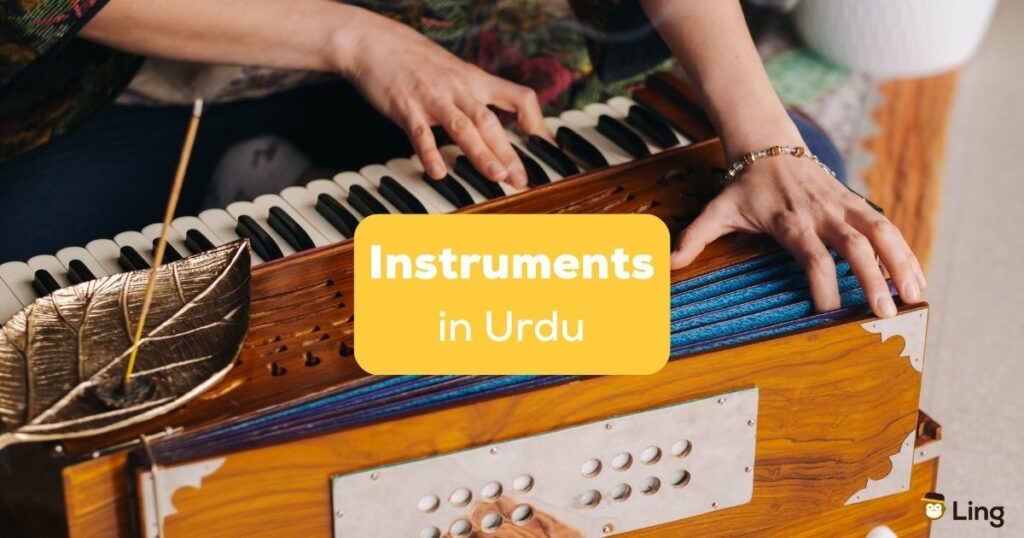I fondly remember an anecdote that an English friend of mine recounted. “The first time I heard the enchanting sound of the sitar, I was so taken aback by the intricate melodies. I wondered if it was a guitar on steroids! Little did I know that I was listening to one of the most iconic musical instruments in Urdu culture, which has a rich history dating back centuries,” she said.
In this article, we’ll explore the fascinating world of musical instruments (Saaz – ساز) in the Urdu culture, from the sitar to the tabla and beyond. Get ready for a journey through the sounds and rhythms of a vibrant musical tradition.
Music Culture Of The Urdu-Speaking Regions
The Urdu word for music is mosiqi (موسیقی). Music has been an integral part of the Urdu language and culture for centuries, with a rich history that dates back to the Mughal era. Urdu music is a blend of diverse musical traditions, including Persian, Indian, and Central Asian music, which have evolved over time and created a unique sound that is instantly recognizable.
Urdu music is characterized by its intricate melodies, complex rhythms, emotional depth, and various devices of music. It is often associated with Sufi poetry and is used to convey a range of emotions, from love and devotion to longing and sadness. Classical music is an important part of Urdu culture, with the sitar, tabla, and harmonium (ہارمونیم) being some of the most iconic instruments used in this genre. These instruments are used to create complex ragas – melodic structures that express a particular mood or emotion through a combination of several musical tones or sounds.
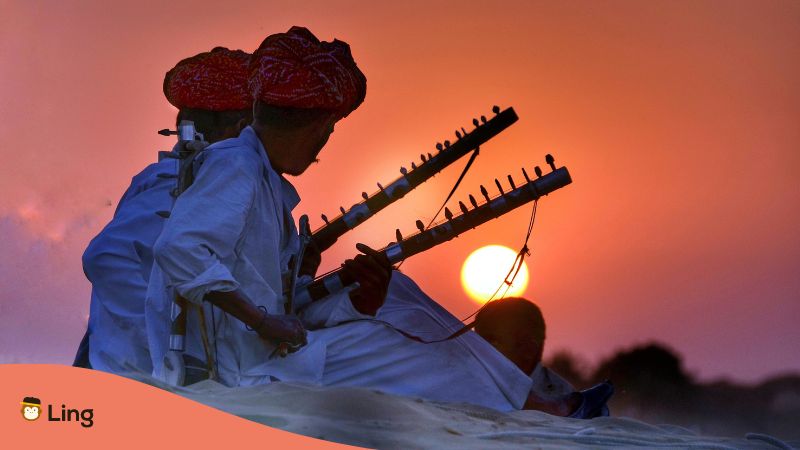
Devotional music is also an important part of Urdu culture, with qawwali being one of the most popular genres. Qawwali (قَوَّالی) is a form of devotional music that originated in the Indian subcontinent and is most often sung to the beats of handclaps and drums. It is characterized by its powerful vocals and use of the instrumental score from harmonium, tabla, and dholak. The lyrics of qawwali are often based on Sufi poetry and are used to express devotion to God.
Folk music is another important part of Urdu culture, with regional variations in style and instrumentation. It is often performed at weddings, festivals, and other social gatherings to celebrate the joys of life. Instruments such as the sarangi, rubab, and dholak are commonly used in folk music, and the lyrics are often based on local traditions and folklore.
Musical Instruments In Urdu Culture
Listed below are the instruments that have been an integral part of Urdu music and are used in a variety of genres, including classical, devotional, and folk music. Some of these instruments produce musical tones or sounds that are absolutely unique to the Indian subcontinent, to which the English language does no justice! Let’s have a look!
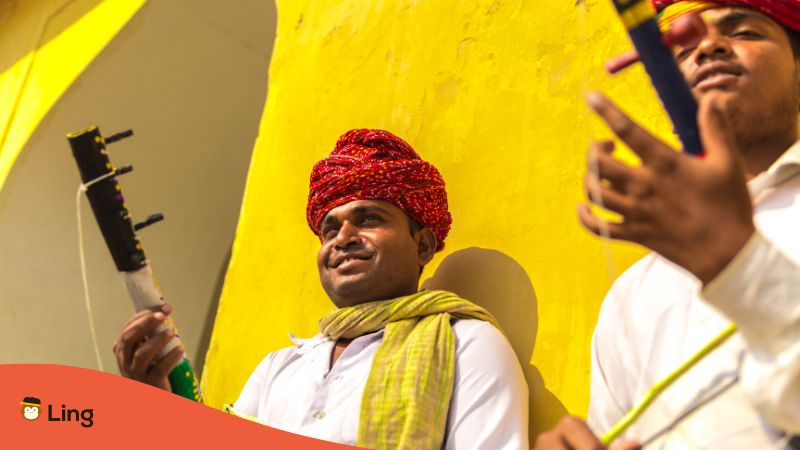
#1 Sitar
A sitar (سِتار) is a stringed musical instrument that originated in India and is widely used in Urdu and Hindustani classical music. It has a long, hollow neck with twenty movable frets and six or seven strings that are played with a plectrum or a finger. The main resonating chamber of the sitar is a large, pear-shaped gourd called the tumba, which is attached to the neck.
The sitar produces a unique, rich sound with a distinct timbre that is often described as soothing and enchanting. It is one of the most iconic instruments used in Urdu culture and has been played by many legendary musicians over the years.
#2 Tabla
The tabla (طبلہ) consists of two wooden drums that are covered with animal hide, usually goat skin. The player uses their fingers and palms to strike the drums and create a range of rhythmic patterns and sounds. The tabla is a versatile instrument that often features in a duet with another instrument in jugalbandi – an act where two musicians engage in a friendly banter through their vocals or instruments.
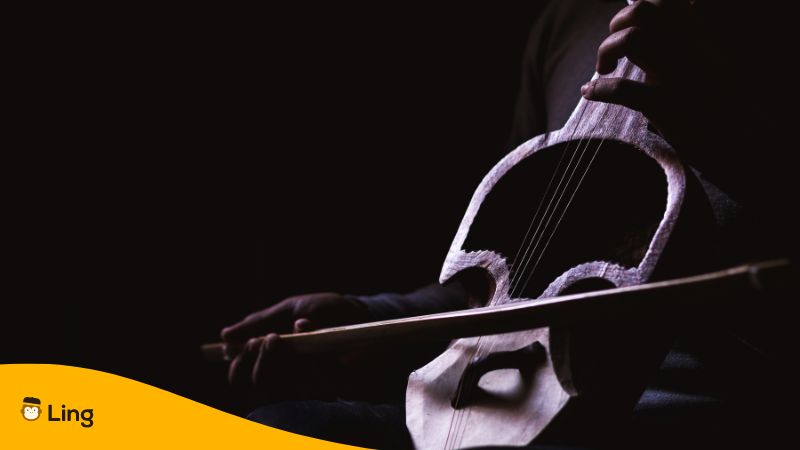
#3 Sarangi
A sarangi (سارن٘گی) is a bowed, stringed musical instrument made of wood with a small, hollow body and three main playing strings, as well as several sympathetic strings. The player uses a horsehair bow to produce sound by moving it across the strings. The sarangi produces a rich, haunting sound that is often compared to the human voice. It is a difficult instrument to master and requires years of training and practice.
#4 Dholak
Dholak (ڈھولک) is a two-headed wooden drum that has a rounded body with a narrow neck. The two drumheads are made of animal hide and are held together by ropes or leather straps. It is played using both hands to create a lively, upbeat rhythm that is perfect for dancing and is used in a variety of settings, from street performances to weddings and festivals.
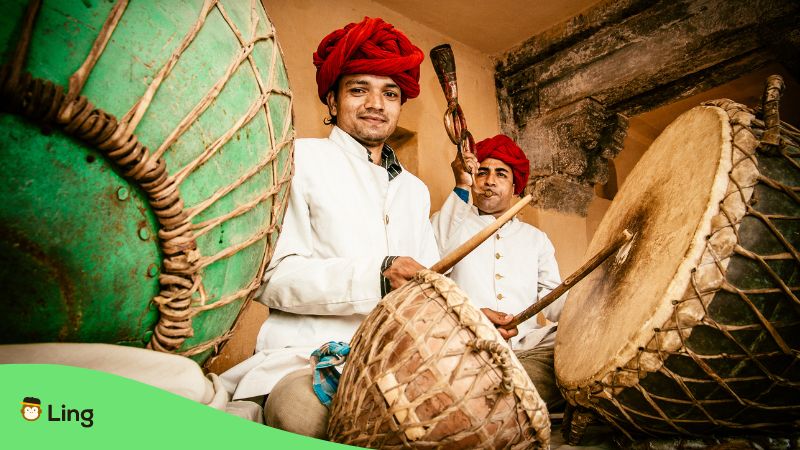
#5 Shehnai
Shehnai (شہنائی) is a wind instrument made of wood with a narrow, tapered bore and a flared bell at one end. It has a double reed that produces a unique nasal sound when air is blown into it. The player uses circular breathing to produce a continuous sound and can create a range of tones and pitches by adjusting their embouchure and finger placement on the finger holes.
The shehnai is a popular instrument for celebrations and is often used to announce the arrival of a bride or groom in a wedding procession. Late Ustad Bismillah Khan is hailed as the shehnai maestro across the globe, who was invited to perform at the prestigious Lincoln central hall in the United States of America.
#6 Bansuri
A bansuri (بانسری) is an Urdu instrument whose name means ‘sound of bamboo,’ as the word for bamboo in Urdu is ‘bans.’ It is a traditional bamboo flute, typically 12 to 30 inches long. The player blows air into the blow hole and uses their fingers to cover or uncover the six or seven finger holes to produce different notes. The bansuri is used to produce musical notes that are warm and mellow in tone. It is a difficult instrument to master and requires skill for proper breath control and finger placement.
#7 Rubab
The rubab (رباب) is a lute-like stringed instrument that has a wooden body with a long neck and three or four main playing strings, as well as several sympathetic strings. The player uses a plectrum or their fingers to pluck the strings and create a range of notes and tones. The rubab produces a rich, resonant sound that is often compared to the human voice. It is a challenging device that requires skill and practice of superlative order but is popular for its unique sound and expressive capabilities.
Upgrade Your Urdu With Ling
To explore more such richness, you can make your way to the Ling app. It is a gamified language-learning platform with interactive features and other fun elements like quizzes which not only keep you hooked for more but help you advance your language skills in real time. And what’s more? You can choose to learn from a pool of more than 60 languages!
So, put your time to proper use, head to your Google Play Store or App Store, and start your exciting language-learning adventure with the Ling app – it’s free!
